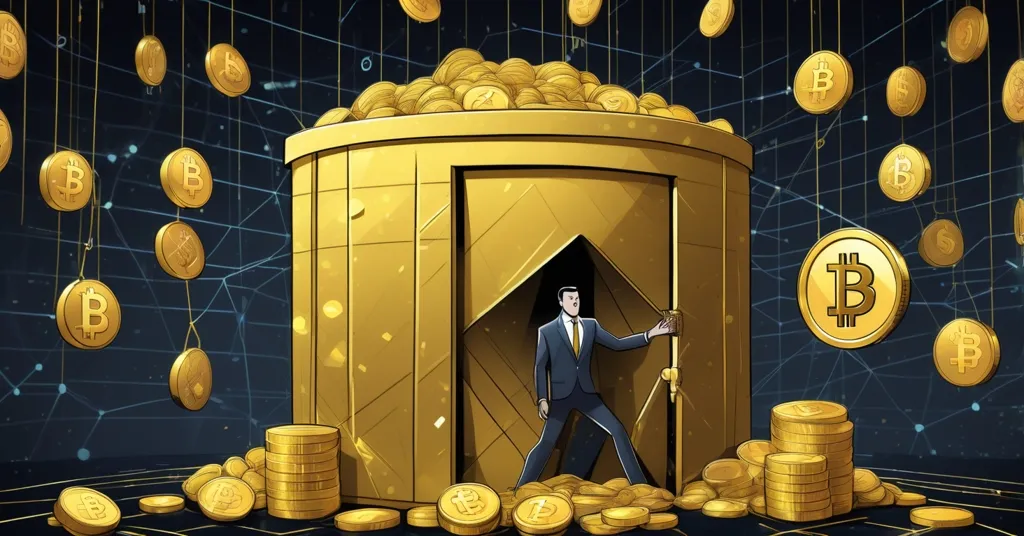Binance Staking 2025: Passive Crypto Income or Centralized Control Trap?

Binance Staking in 2025: Your Ticket to Passive Crypto Gains—Or a Centralized Trap?
Want to earn crypto without breaking a sweat? Binance staking promises just that, offering a slick way to lock up your coins and rake in rewards while supporting blockchain networks in 2025. As the world’s largest exchange with over 200 million users, Binance makes it dead simple—but at what cost to your freedom and the ethos of decentralization?
- Core Concept: Binance staking lets you earn passive income by locking cryptocurrencies in Proof of Stake (PoS) networks.
- Wide Reach: Over 100 coins globally, only 20 on Binance.US, with options like Locked, Flexible, and DeFi staking.
- Hidden Edges: High fees, market risks, and centralization clash with crypto’s core promise of autonomy.
What Is Staking, and Why Binance?
Staking is the process of committing your cryptocurrency to a blockchain network to validate transactions and secure the system. Unlike Bitcoin’s energy-guzzling Proof of Work (PoW), PoS networks—think Ethereum, Solana, or Cardano—rely on staked coins for consensus, rewarding participants with a cut of the pie, often measured as an Annual Percentage Rate (APR), similar to interest on a savings account that fluctuates daily. Binance, the heavyweight of crypto exchanges since its 2017 debut, acts as your middleman. They handle the tech-heavy lifting—no need for you to run a validator node or mess with hardware—making staking accessible to anyone with a few clicks via their “Simple Earn” feature. With daily trading volumes topping $20 billion, their scale is unmatched, but scale often breeds compromise. For a deeper look at the Binance staking process, their history and operations offer crucial context.
Globally, Binance lets you stake over 100 PoS coins, from Ethereum (currently at a modest 1.24% APR) to stablecoins like Tether (USDT) with a tempting 12.2%. Other options include Solana (SOL) at 5.1%, Polkadot (DOT) at 5.8%, Cardano (ADA) at 2.1%, and USD Coin (USDC) at 11.61%. These rates are just a snapshot—network dynamics or market shifts can flip them overnight. For U.S. users, Binance.US is a pale shadow, restricted to about 20 coins due to regulatory red tape, and it gouges with fees from 9.95% to a staggering 39.95% on rewards, compared to a max of 10% globally. Reward payouts? Daily or weekly for global users, mostly weekly for Americans. If you’re stateside, you’re playing a rigged game—stick to the international platform if you can. Check out this fee comparison between global Binance and Binance.US for a detailed breakdown.
Binance Staking Options: Pick Your Poison
Binance serves up a menu of staking flavors to match your risk tolerance and liquidity needs. Here’s the breakdown with a real-world twist to keep it grounded:
- Locked Staking: Tie up your funds for a set period—30, 60, or 90 days—for higher rewards. It’s like a fixed deposit at a bank: better returns, but your money’s off-limits. Great if you’re a long-term hodler, brutal if the market crashes and you’re stuck.
- Flexible Staking: Lower rewards, but you can pull out anytime. Think of it as a savings account with quick access—handy for the skittish or those expecting volatility.
- DeFi Staking: Dive into decentralized finance by lending or borrowing via blockchain protocols, with Binance as your bridge. It’s like investing through a third-party app—higher risk, higher potential, but smart contract bugs could bite.
- Ethereum Staking (Beacon Chain): Lock up ETH for the long haul to support Ethereum’s post-merge PoS system. You get BETH tokens representing your stake plus rewards, but your actual ETH is untouchable for years. It’s a bet on Ethereum’s future—hope you’re patient.
Each comes with quirks. Unstaking can take up to 24 hours for some coins, and lock-ups mean you’re a spectator if prices tank. Read the terms, or you’ll be the sucker praying for a rebound. For community insights on Ethereum staking risks and BETH token updates, discussions on platforms like Reddit provide raw user experiences.
Security: Fort Knox or a Fancy Facade?
With 200 million users trusting Binance, they’ve got no choice but to lock down their platform. They deploy two-factor authentication (2FA), stash most funds in cold wallets—offline storage safe from hackers—and run the Secure Asset Fund for Users (SAFU), funded by 10% of trading fees to cover losses from breaches. Their Proof of Reserves (PoR) system, beefed up with zk-SNARKs (a privacy tech that hides user data while proving asset ownership), lets you verify they’ve got the goods. CoinBureau calls their security a “defining pillar” of trust, noting their knack for adapting to threats. Since 2018, SAFU has been a safety net, and open-source PoR updates since 2023 add transparency. For an in-depth expert analysis on Binance’s security measures, there’s plenty to dig into regarding centralized exchange vulnerabilities.
But don’t get too cozy. SAFU won’t save you from market meltdowns or your own dumb mistakes—lose your password, kiss your funds goodbye. DeFi staking risks smart contract flaws outside Binance’s control. And let’s not forget: even the toughest vaults can’t dodge systemic cracks. Crypto’s a wild frontier; no fortress is bulletproof.
The Big Perk: Passive Income Without the Hassle
The draw of Binance staking is obvious. Passive income without running a node or burning electricity like a Bitcoin miner? Sign me up. You’re also bolstering blockchain security, a noble nod to the ecosystem. For newbies, it’s a gateway—click a button, stake some USDT, watch rewards trickle in. For OGs, the variety of coins and plans offers flexibility without needing tech chops. Binance has onboarded millions since staking rolled out, a win for mass adoption and a nod to effective accelerationism, pushing crypto into the mainstream faster than raw tech ever could. If you’re curious about how to earn passive rewards through Binance staking, detailed guides can walk you through the steps for 2025.
The Ugly Flip Side: Risks and Rip-Offs
Now, let’s cut the fluff. Staking on Binance isn’t a golden goose—it’s a gamble with sharp edges. Market volatility is the big bad wolf. Your staked SOL might earn 5.1% APR, but if its price nosedives 20% in a week, you’re in the red, locked funds or not. Imagine staking $10,000 of SOL for 90 days, only to see its value drop to $8,000 while you’re stuck. APRs aren’t guaranteed either—they’re like a rollercoaster, dipping if too many stake or if Binance tweaks terms. Check real-time rates before diving in. For user perspectives on Binance staking risks versus rewards, community forums offer unfiltered takes.
Fees? Borderline predatory, especially for U.S. users. Up to 10% globally is bad enough, but 39.95% on Binance.US? That’s not a fee, it’s a crypto carjacking. Lock-up periods add insult—if the market flips, you’re a bystander. Unstaking delays of 24 hours for some coins can sting during a flash crash. And while Binance handles the tech, you’ve got zero say in how your staked assets influence network governance. Convenience comes at a steep price. If you’re wondering if Binance staking is safe for passive income, platforms like Quora host debates on potential pitfalls.
The Decentralization Dilemma: Goliath vs. Crypto’s Soul
Here’s where we play devil’s advocate with a sledgehammer. Binance staking is centralized as sin. You’re handing your keys to a single entity controlling your assets and voting power in PoS networks like Polkadot or Solana. If Binance flops—whether from a hack, outage, or regulatory smackdown (remember CZ stepping down in 2023 over U.S. money laundering charges?)—you’re collateral damage. Compare this to direct staking: running an Ethereum validator node needs 32 ETH (a hefty chunk) and constant uptime, but it’s pure control, no middleman skimming fees or playing puppetmaster. For a broader discussion on centralization issues in staking platforms, the risks of concentrated power are laid bare by experts.
Alternatives like Lido offer liquid staking—stake ETH, get tradeable tokens, keep some autonomy—with less centralization, though risks remain. Coinbase, a Binance rival, matches fees but lacks coin variety. Binance’s ease is a pragmatic on-ramp for millions, but it’s a gut punch to decentralization purists and Bitcoin maximalists who see PoW’s miner chaos as freer than PoS’s staked hierarchies. We champion disrupting the status quo, yet Binance often feels like swapping one banker for another. Are we building a liberated future or just polishing a prettier cage?
Binance vs. The Field: How Does It Stack Up?
Let’s size up the competition. Coinbase staking offers similar ease but supports fewer coins and mirrors Binance’s fee greed—often 25-35% of rewards. Lido’s liquid staking for Ethereum lets you trade staked assets via tokens like stETH, dodging lock-ups, but smart contract risks loom larger than Binance’s SAFU safety net. Direct staking, say on Ethereum, cuts out middlemen entirely—32 ETH gets you a validator node, costing about $1,000 yearly in hardware and upkeep for full control. It’s a slog, but it’s yours. Binance wins on simplicity and scale, a lure for the masses, yet sacrifices the soul of blockchain freedom. Pick your poison based on principles or practicality. To understand the fundamentals of Proof of Stake versus Proof of Work, comparisons highlight why these trade-offs matter.
2025 Outlook: Regulatory Shadows and Tech Shifts
Peering into 2025, Binance staking faces headwinds and tailwinds. Regulatory heat, especially post-2023’s legal dramas with CZ, could tighten U.S. restrictions further, slashing Binance.US offerings or jacking fees even higher. Globally, nations might follow suit—imagine staking bans or forced KYC tightening access. On the flip side, Ethereum’s ongoing upgrades could boost staking demand, nudging APRs or drawing more to Binance’s Beacon Chain option. Tech-wise, if Binance refines PoR or cuts fees to compete, they could solidify their grip. But one misstep—a hack or governance scandal—could tank trust overnight. Staking’s future on this platform hinges on balancing user growth with crypto’s rogue spirit.
Bitcoin’s Take: Why PoW Still Rules for Some
As Bitcoin maximalists at heart, we’ve got to toss in a reminder: Bitcoin sidesteps staking’s mess entirely. Its PoW model, while energy-hungry, spreads power among miners, not centralized stakers or exchanges holding voter sway. No passive income, sure, but no lock-ups or fee-gouging either. Bitcoin’s chaos is its strength—decentralization baked in, not negotiated. Altcoins and PoS fill niches Bitcoin doesn’t touch, like yield or scalability, but they often trade freedom for features. Binance staking amplifies that trade-off. Worth it? You decide.
Key Takeaways: Binance Staking Unpacked
- What is Binance staking, and how can beginners get started?
It’s locking up crypto on Binance to support PoS networks and earn rewards. Head to “Simple Earn,” pick a coin, select Locked or Flexible staking, and commit—Binance handles the nerdy stuff while you collect passive gains. - Which coins offer the best staking rewards on Binance for 2025?
Stablecoins like USDT (12.2% APR) and USDC (11.61%) top the charts globally, with Solana (5.1%) and Ethereum (1.24%) as solid picks. Rates shift—always check Binance for live numbers before staking. - How do staking fees differ for global vs. U.S. users on Binance?
Global users pay up to 10% on rewards, while Binance.US users get slammed with 9.95% to 39.95%, plus fewer coins (20 vs. 100+), thanks to U.S. regulatory chokeholds. - What are the real risks of staking crypto on Binance?
Brace for market crashes tanking your asset value, lock-ups freezing funds, APRs that fluctuate, extortionate fees (especially U.S.), and unstaking delays up to 24 hours during critical moments. - Is Binance secure enough for staking my crypto in 2025?
With 2FA, cold storage, and SAFU covering hack losses, it’s solid for a centralized hub. But market drops, user errors, and DeFi bugs aren’t their problem—crypto’s wild, so stay sharp. - Does Binance staking clash with crypto’s decentralization ethos?
Damn right it does. Binance controls your assets and PoS voting power, a far cry from blockchain’s no-middleman promise. It’s an easy entry for many, but a compromise on freedom.
Binance staking in 2025 dangles the carrot of easy rewards, tearing down barriers for newbies and veterans alike to join the PoS party. With slick tools and a sprawling coin roster, it’s a turbo boost for crypto adoption, aligning with our push for rapid progress. Yet the thorns are glaring—sky-high fees, locked funds in a volatile hellscape, and a centralized chokehold that mocks the very freedom we fight for. As champions of disruption and privacy, we can’t ignore that Binance, for all its muscle, often mirrors the gatekeepers we aim to topple. So, will you stake for a quick buck, or hunt purer paths on-chain, fees and headaches be damned? Crypto’s future isn’t just about fattening wallets—it’s about who holds the reins. Choose wisely.


